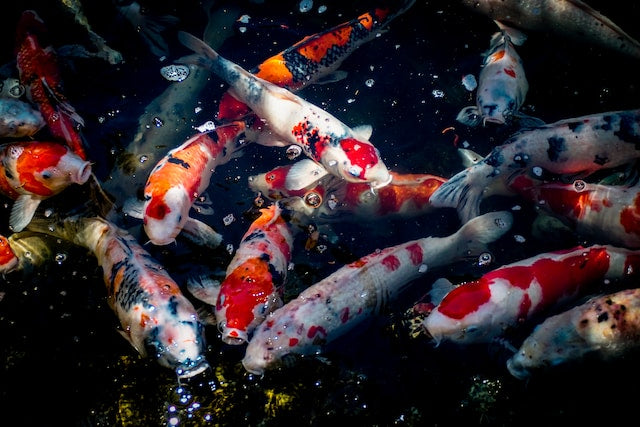Its lovely seeing new Koi fish explore their new surroundings and meet your other Koi fish, but there are risks involved and precautions that should be taken when introducing new Koi fish. The risks are usually based around stress, water quality changes and parasitic outbreaks.
Stress
When you introduce a new Koi fish, there is unavoidable stress involved. The catching, bagging, and transporting process will involve a small amount of stress for the new Koi fish – but the resident Koi fish who are already established in the pond can also experience stress. Every pond is different in its biological balance, thousands of strains of bacteria make up a unique aquatic ecosystem. Even if you had two identical ponds in the same garden, using the same supply water – if they are contained, separate bodies of water, they will be unique in terms of their biological build and the risks will be the same. The new Koi fish brings new strains of bacteria which will begin to colonise in your pond. The resident Koi fish sense this change.
Water Quality
New Koi fish bring changes in water quality parameters too – dissolved oxygen levels and changes in ammonia levels, even on a tiny scale, will invoke changes in the entire nitrogen cycle (ammonia (NH3), nitrite (NO2) and nitrate (NO3) levels). For the resident Koi fish, change can be stressful and just like us humans – stress equals a compromised immune system and leaves them open and vulnerable. A good understanding of the nitrogen cycle is beneficial here.
Parasites
Parasites are generally opportunistic and will take advantage of stressed Koi fish with a comprised immune response. If your Koi fish have a parasite outbreak after the introduction of a new Koi fish, it doesn’t automatically mean you were sold a sick Koi fish – chances are the Koi fish was perfectly healthy when it was sold, and this is down to unavoidable stress factors. Look at it like this, parasites are always present, testing that immune system of a Koi fish and waiting for a moment of weakness that allows them to take hold. Where do they come from? Where do they hide? I’m not sure anybody truly knows the answer to this. They are certainly there though and so understanding the symptoms of a parasite outbreak is important.
Temperature
We should avoid a notable temperature difference between your pond water and the water in the shop. The water in our shop is significantly warmer compared to unheated, outdoor ponds and so for this reason we avoid selling Koi fish during the colder months. This isn’t a problem if you have a heated pond, and we can reserve koi during the winter for collection/delivery in the spring when temperatures are more stable. It’s also worth noting, most treatments for sick Koi fish lose their effectiveness at temperatures below 10-12 degrees Celsius. Another reason to avoid introducing new Koi fish in the colder months.
What To Do
- Give your pond a good clean. Flush the filters, ensure the pond pump is clean and the flow rate is where it should be.
- Test your pond water. PH, KH, ammonia, nitrite, nitrate, temperature, and dissolved oxygen. Let staff know these parameters when collecting your Koi fish.
- Float the bag on the pond surface for 30-45 minutes.
- After 30-45 minutes, open the bag and release the Koi fish.
You may see elsewhere that others recommended floating the bag, opening it, adding a small amount of pond water, and then re-sealing the bag before repeating the process multiple times. Also, it is often recommended to try and remove the Koi fish but dispose of the water in the bag. Understandably, by introducing the water little-and-often you may be benefiting the acclimatisation process, but on the other hand, is the stretched-out process increasing the stress on the Koi fish and the resident Koi fish?
The water in the bag will no doubt be high in ammonia, especially if the new Koi fish has been on a substantial journey – it makes sense to throw this water away and not put it in your pond, but on the rebound, if you lack experience handling Koi fish you could potentially damage the new Koi fish trying to remove it from the bag. You pond and filtration system should be more than equipped to comfortably deal with the ammonia contents of a bag. If not, you should be addressing that before introducing new Koi fish.
What To Look For?
If it does go wrong, don’t panic. You can do everything right and it can still go wrong. Learning how to spot sick Koi fish and treating them is part of the Koi fish keeping journey. It can easily be fixed. Familiarising yourself with symptoms is important. Symptoms are generally the same across the board, for both water quality issues and parasitic outbreaks.
Keep an eye out for:
- Flashing or flicking. The Koi fish rubbing their flanks in a swift movement – their way of itching.
- Excess mucus is produced as a natural defence. This gives a cloudy looking appearance either in patches or across the entire Koi fish.
- Not swimming much, maybe sitting on the bottom.
- Holding their fin(s) against their body.
- Gasping for air at the surface.
- Heavy breathing.
- Excessive jumping.
- Not eating.
If you see any of these symptoms, contact us and we will give you advice.

